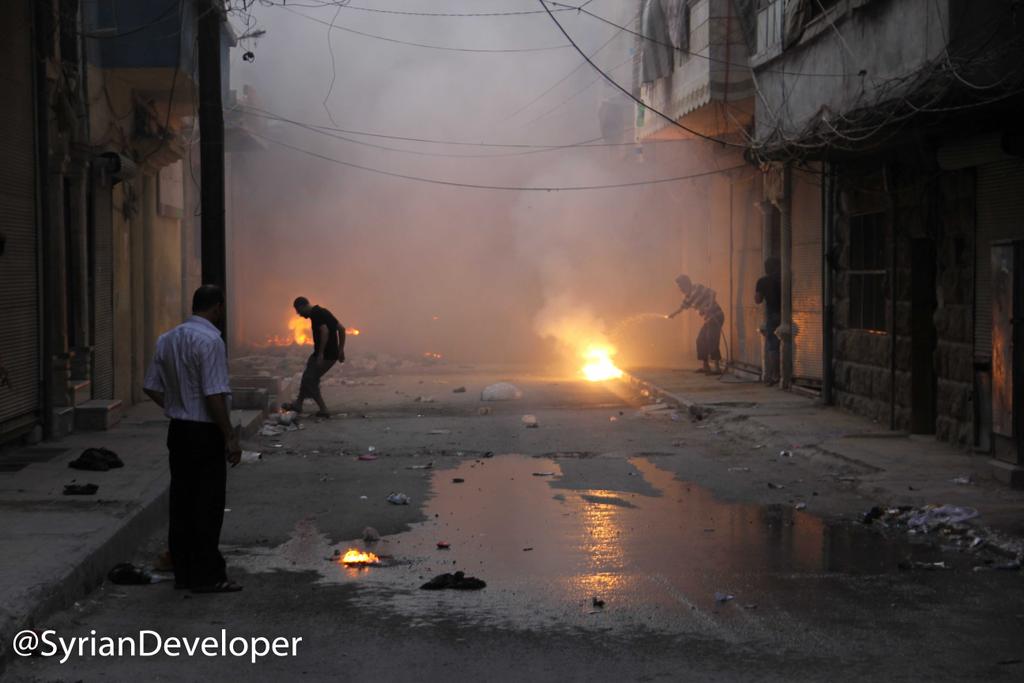
The joint Syrian-Russian military operation has been using incendiary weapons, which burn their victims and start fires, in civilian areas of Syria in violation of international law, Human Rights Watch said on Tuesday.
Incendiary weapons have been used at least 18 times over the past nine weeks, including in attacks on the opposition-held areas in the cities of Aleppo and Idlib on August 7, 2016.
“Countries meeting at the Convention on Conventional Weapons (CCW) in Geneva on August 29, 2016 should condemn the use of air-dropped incendiary weapons in civilian areas of Syria in violation of the treaty’s Protocol III on incendiary weapons. They should encourage Syria to join the protocol and press Syria and Russia to immediately stop using incendiary weapons in civilian areas. They should also review the protocol and take steps to strengthen it,” HRW said.
“The Syrian government and Russia should immediately stop attacking civilian areas with incendiary weapons,” said Steve Goose, arms director at Human Rights Watch. “These weapons inflict horrible injuries and excruciating pain, so all countries should condemn their use in civilian areas.”
Total inferno in Hayan as Russian warplanes scorch the town with white phosphorus. #Aleppo #Syria pic.twitter.com/I7XXnem0EO
— Rami (@RamiSafadi93) June 20, 2016
A Human Rights Watch review of photographs and videos recorded at the time of attack and of the remnants afterward indicates there were at least 18 incendiary weapon attacks on opposition-held areas in Aleppo and Idlib governorates between June 5 and August 10. At least 12 civilians were reported wounded by witnesses and first responders in five of these attacks.
An incendiary weapon attack on the opposition-held Idlib city on the evening of August 7 wounded at least two civilians, witnesses said.
“I saw with my own eyes two strikes, both ‘phosphorus’—blocks of flame were falling from the sky,” said. Ala’ Abdel Aziz Hmeidan, an Idlib resident. “After that, there was a strike with a missile carrying cluster bombs. It was tragic, buildings were on fire, rocks were on fire.” He said the area contains residential buildings and that there were no armed groups in the vicinity.
#Russia dropping Phosphorus & Napalm on high populated areas #Aleppo https://t.co/o8r9MrERd4
— MEMO (@sheikhsexy1) June 20, 2016
Syria Civil Defense, an opposition search-and-rescue volunteer group, reported an incendiary weapon attack on the residential area in al-Mashhad in opposition-held east Aleppo city at around 4 p.m. on August 7 that injured a child. Photographs taken immediately after the attack by Aleppo resident Malek Tarboush show at least four incendiary submunitions burning on the ground in a narrow street that contains at least one shop. Human Rights Watch was unable to identify the specific type of incendiary weapon used in the attack.
Incendiary weapon attacks in Syria have increased significantly since the Russian Federation began its joint military operation with the Syrian government on September 30, 2015. There is compelling evidence that Russian government aircraft are being used to deliver incendiary weapons or at least are participating with Syrian government aircraft in attacks using incendiary weapons.
قام الطيران الروسي اليوم بإستهداف حي #المشهد بقنابل الفوسفور #حلب #سوريا pic.twitter.com/9wtcgqXwo9
— Malek Tarboush (@SyrianDeveloper) August 7, 2016
More than a dozen countries have condemned or expressed concern at the use of incendiary weapons in Syria since 2013, including Colombia, Sweden, Turkey, UK, and the US in recent weeks. The other states that have condemned the use of incendiary weapons in Syria are Austria, Croatia, Ecuador, France, Germany, Ireland, Lithuania, the Netherlands, Norway, and Switzerland.
Reade more: Russian jets attack Aleppo with Napalm and white phosphorus
“The disgraceful incendiary weapon attacks in Syria show an abject failure to adhere to international law restricting incendiary weapons,” Goose said. “The resulting civilian harm demonstrates the inadequacy of existing law on incendiary weapons, which should be strengthened urgently. From a humanitarian standpoint, a global ban on incendiary weapons would provide the best solution.”
For more information about the incendiary weapons protocol, details of the recent attacks, and evidence of the use of incendiary weapons, please see below.
Goose and Human Rights Watch arms advocacy director Mary Wareham are attending the week-long CCW meeting that opens in Geneva on August 29, 2016.

